
INTRODUCTION
The external and internal morphology (Anatomy) of honey bees essentially corresponds to that of other insects. The same can be said about physiology (vital functions). However there are differences that must be pointed for a better understanding of their ethology (behaviour).
Logically, anatomical peculiarities and vital functions are interrelated.
DIGESTIVE SYSTEM

The mouth is the first part of honeybees’ digestive system. Its shape is a continuous tubular form. It is located in the front of the head. Bees have lapping mouthparts: the labrum or upper lip covers their jaws. Queens, workers and drones have different mandible parts. Worker bees’ jaws are narrower in the central part than in the base. At their ends —where they have horizontal movements— they are smooth and spoon-shaped.
These jaws are used to open the anthers of the stamens and collect pollen from flowers. They are also used to soften, knead and shape wax sheets with saliva and to build cells and honeycombs, as well as to remove foreign elements from hives.
When bees take liquid foods they use a specialized structure: the proboscis. It is formed by different mouthparts and it gets adapted to this kind of use when necessary.
Bees’ tongue is long, flexible, hairy and grooved. Its end it is a kind of spoon-shaped button. It is located between the labial palps and at its proximal end has paraglosses.
The proboscis, at rest, is retracted under the head. When bees want to absorb liquids, they stick it out, extending its distal parts around the tongue. This way, the honeybee form a straw or tube is that closes in front of the maxillas distal end. At the back it is closed by the labial palps.
When the proboscis is extended, bees introduce it in the liquid and do rapid movements back and forward to absorb it. When jaws and proboscis are contaminated, they are the vehicle for infestation of larvae from American foulbrood (Paenibacillus larvae) or European foulbrood (Melissococcus pluton).
The honeybee mouth is located between the bases of the jaws. It gets opened at the end of the suction organ. After its opening, bees’ mouth is arranged vertically along the head to the oesophagus. It is a sac-shaped cavity with muscular walls that allow aspiration (dilators) of fluids from the proboscis and pass them to the oesophagus through the pharynx (compressors).
The oesophagus is a tube that stretches along the thorax. Food advances through it due to its contraction movements.
At the proximal end of the abdomen, the digestive tract widens into a thin, highly elastic sac. In honeybees it specifically called crop or honey stomach. When it is filled with food, its walls expand rhythmically causing its content (pollen, nectar, solid elements) to mix. It is also used as a food store. It serves the bee for the transport of nectar and water from the outside to the hive, where it is regurgitated.
The crop also distends when bees consume solid food or liquid with a large load of viruses which enter through the digestive system. The proventriculus controls food entry into the stomach (ventriculus or midgut) of bees. It acts like a filter, as it eliminates solids elements from the content of the molar crop.
The ventriculus or midgut is the place where digestion and absorption of food material takes place. The folds of its inner membrane increase the digestive surface. The peritrophic membrane protects the epithelium from the direct action of food and leads the passage of digestive juices towards food and from these, when digested, towards the absorption zone.
In larvae, the midgut is the place where Paenibacillus larvae (American foulbrood) attack. The spores of these bacteria germinate in the ventriculus just after the operculation, which is the moment in which the concentration of sugars drops. Later, these bacteria invade the whole larva.
Bees’ midgut is also the place of germination of Ascophaera apis (Ascospherosis) asci. Its hyphae invade larvae and cause their death before the operculation. The Morator aetutalas virus (Sacbrood virus) also begins its invasion through the ventriculus.
It is also the place where the microsporidium Nosema apis (Nosemosis) gets appropriately developed. It multiplies its effectiveness when bees’ defences are low enough to allow it.
The small intestine is the next segment of the digestive system and it ends in the rectum. In this part of the intestine, the Malphygian Tubules, which act as filtering elements (kidneys), empty their contents. In these tubules is located the causative agent of Amebosis (Malpigamoeba mellificae).
In its distal part is the rectal ampulla, which has a main role in the absorption of water and in retaining the faecal material until evacuation occurs outside the hive.
Nosemosis (Nosema apis) produces a large quantity of waste material that, when accumulated in the ampoule, causes a great distension of the midgut, pressing the air sacs and thus preventing the flight.
Here we can also find Malpighamoeba mellificae cysts, which come from the Malphygian tubules. During winter, bees store their waste materials in the rectal ampulla and do not empty it until they carry out the so-called cleansing flights at the beginning of spring.
This strategy followed by honeybees in regard to undigested elements favours extraordinarily the hygiene inside the hive. The presence of faecal spots in different parts of the hive warns bees about the presence of problems of physiological or pathological order.
RESPIRATORY SYSTEM
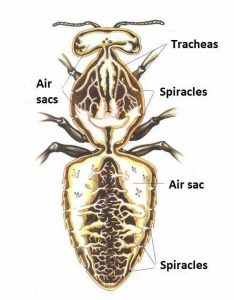 Honeybees do not have a specific organ for gas exchange. This is done by a tracheal system which consists of spiracles, tracheas, air sacs and tracheoles (this is where gas exchange really occurs).
Honeybees do not have a specific organ for gas exchange. This is done by a tracheal system which consists of spiracles, tracheas, air sacs and tracheoles (this is where gas exchange really occurs).
The spiracles are external holes that used for ventilation. Both in larvae and adults there are 10 pairs and all of them except the second —which is very small— have closing valves. Spiracles are opened in response to low concentrations of oxygen or high concentrations of carbon dioxide in tissues, allowing the air to enter and exit.
The valve of the first spiracle does not close completely; bees remedy this with hairs. This first spiracle is also the entry point of the mite Acarapis woodi (Acarapisosis). This mite enters especially in new born or young bees, crossing the hair barrier —that in these bees is not very hardened—. The causative agent of septicemia also enters through this spiracle.
Tracheas are conduits that communicate spiracles with the air sacs. The longest are those those of the first pair. In these is where A. woodi predominates. This mite feeds on hemolymph and obtains it by perforating the trachea. This causes processes of melanisation on it.
The main tracheas extend to the sides of the body and form large widenings on the sides of the abdomen.
Gas exchange occurs in the so-called tracheoles. Bees lack lungs similar to mammals; oxygen is directly carried to all parts of the body by a series of tubes called tracheas.
Honeybees’ breathing is almost opposite to that of all vertebrates. Instead of directing the blood towards the air —that is, towards the lungs—, air is transported towards the blood. Honeybees’ blood is a clear and yellowish liquid (called hemolymph). Oxygen reaches tissue proximities and reduces the transport of gases in liquid phase to a minimum.
Air sacs (or tracheal sacs) are constituted by a tracheal widening and are distributed by the body in an irregular manner. They collapse because of the pressure and play an essential role in tracheal ventilation. They intervene in the flight mechanism. All of the sacs are interconnected.
NERVOUS SYSTEM
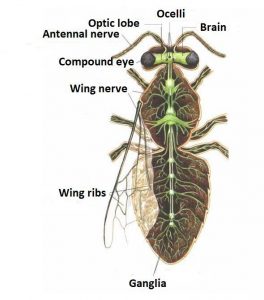 Larvae have a brain with a suboesophageal ganglion, as well as eleven ganglia, longitudinal corners formed by pairs of twin nerves. Adult bees have a larger brain with a suboesophageal ganglion, as well as seven ganglia which form a ventral cord that runs below the gastrointestinal tract.
Larvae have a brain with a suboesophageal ganglion, as well as eleven ganglia, longitudinal corners formed by pairs of twin nerves. Adult bees have a larger brain with a suboesophageal ganglion, as well as seven ganglia which form a ventral cord that runs below the gastrointestinal tract.
In the thorax are two thoracic ganglia. The nerves that come from the first of them are directed to the first pair of legs. The nerves of the second ganglion are directed towards the flight muscles and the second and third pairs of legs.
In the abdomen there are five other ganglia that regulate intestines and breathing organs functions. The last two, somewhat larger than the others, regulate the reproduction organs and the stinger. As a consequence of this nervous system distribution, each of the three parts of honeybees body (head, thorax and abdomen) function more or less independently.
We can see this by cutting off the head of one of these insects. We will see that the rest of the body can continue moving from one part to another, moving the wings and continue their vital functions for a long time, but irretrievably dying in the end.
The same thing happens if we cut the abdomen. The insect can continue to absorb liquids, nectar and syrups, but everything that is ingested will immediately come out to the outside. Worker bees’ brain is much larger than that of the drones in spite of being the head of the last ones greater.
Our greatest interest lies in the fact that it is the target of neurotropic viruses.
CIRCULATORY SYSTEM
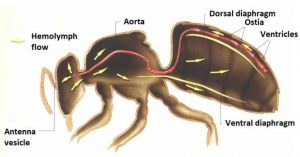 The circulatory system of honeybees is composed of a long tube that runs throughout their body. It is closed at the abdominal end and opened in the head. It stretches along the digestive track.
The circulatory system of honeybees is composed of a long tube that runs throughout their body. It is closed at the abdominal end and opened in the head. It stretches along the digestive track.
Its main function is the transport of nutrients and removal of waste. Its components are; hemolymph, ventral and dorsal diaphragms, heart, aorta and antennae vesicles.
The hemolymph is a complex fluid that contains cells called lymphocytes. These cells have phagocytic capacity, do their own movements and circulate freely through the body every time it is driven by the heart to the brain.
Nosema apis (Nosemosis) causes anemia. We can also find Pseudomonas aeruginosa (P apiseptica) here.
In the dorsal part of the abdomen there is an organ called heart. Bees’ heart is formed by ventricles joined together by valves called ostia. Ostiolar chambers are joined by valves that open only forward, this allows the advancement of hemolymph, but not its recoil.
The dorsal and ventral diaphragms are responsible for circulation in the abdomen and help blood to return from the thorax. Antennae vesicles pump blood to the antennae.
EXCRETORY SYSTEM
It is formed by the malpyghian tubules, which remove waste substances from blood and pour them into the anterior intestine to eliminate them with faeces. These substances are mainly nitrogen derivatives. It is the target of Malpighamoeba mellificae.
FAT CELLS
They form thin membranes that are scattered along the abdomen walls. In winter these cells are poor in fat and rich in albumin, while in summer is the other way around. Among fat cells are the oenocytes, which are cells related to wax metabolism. These cells, along with fat, contain proteins and glycogen. Pseudomonas apiseptica grows here before invading the blood.
REPRODUCTIVE SYSTEM
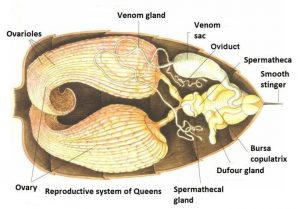 In queens it is constituted by two pear-shaped ovaries. These are constituted by long tubes called ovarioles, which end in little tips. These tips are inserted near the ventral side of the heart. Ovarioles are full of ovules (oocytes) in different stages of maturation.
In queens it is constituted by two pear-shaped ovaries. These are constituted by long tubes called ovarioles, which end in little tips. These tips are inserted near the ventral side of the heart. Ovarioles are full of ovules (oocytes) in different stages of maturation.
At the end of the ovary it is also the chorion. A queen can lay up to 3,000 eggs per day, although it is normal for them to put up to 1500. In a year a queen can lay up to 200,000 eggs.
Ovaries end in separate oviducts, which then join in a common conduit, or middle oviduct. At its base it communicates with the spermatheca, which is where the spermatozoa of copulas are accumulated until their use.
This system continues with the vagina, which ends at the vaginal opening, which is protected by a fold. At that height there are two lateral bags and the bursa copulatrix.
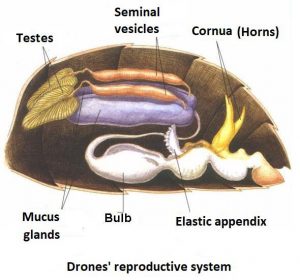 Drones’ reproductive system is made up of two testes, two vasa deferentia, two seminal vesicles, two mucus glands, ejaculatory duct and copulatory organ. Testes are formed the testicular tubes inside them is where spermatozoa are produced. As the drones mature, testes lose size until they get reduced to 1/3 of their original size (pre-birth).
Drones’ reproductive system is made up of two testes, two vasa deferentia, two seminal vesicles, two mucus glands, ejaculatory duct and copulatory organ. Testes are formed the testicular tubes inside them is where spermatozoa are produced. As the drones mature, testes lose size until they get reduced to 1/3 of their original size (pre-birth).
The vasa deferentia communicate testicles with the seminal vesicles. In this path, spermatozoa continue to mature.
The seminal vesicles produce secretions that accompany spermatozoa and inside them they finish maturing. Mucus glands communicate with the seminal vesicles and the ejaculatory duct. They produce a substance that solidifies in contact with air and water, but not with seminal secretions.
The ejaculatory duct communicates the mucus glands with the copulatory organ. The copulatory organ in the resting state is invaginated. When it gets evaginated, it is introduced in queen’s bursa copulatrix and it is detached from the drone once semen is introduced, functioning as a stopper.
Drones’ abdominal muscles are very developed. This is important from the physiological point of view, so that at the moment of copulation the endophallus eversion can be produced quickly.
GLANDULAR SYSTEM
A gland is a specialized organic formation or a set of cells differentiated from the epithelial tissue. Glands are responsible for elaborating, secreting and excreting certain substances that exclusively intervene in certain physiological processes.
Hypopharingeal glands.
They are located in the head of worker bees. They are spherical-shaped and very developed in the nursery stage. In queens they are rudimentary and in drones they do not exist. Its secreting cells are grouped in clusters and pour their secretion in the lower part of the larynx through a central duct. Here is the Sacbrood Virus.
Their secretion’s product serves as food for larvae in their first three days of life and for queens throughout their lives. It’s the well-known royal jelly. When bees mature, these glands lose their functionality, their volume decreases and they start producing the invertase, necessary to cause the cleavage of nectar sugars.
Salivary glands.
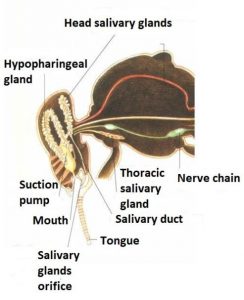 These glands are found in head and thorax (post-cerebral or thoracic). The two common ducts pour saliva (slightly alkaline aqueous liquid) on both sides of the tongue.
These glands are found in head and thorax (post-cerebral or thoracic). The two common ducts pour saliva (slightly alkaline aqueous liquid) on both sides of the tongue.
Saliva helps dilute honey and dissolve sugar crystals. In addition, it moistens the substances involved (pollen at the time of collection). It also contains enzymes which are responsible for the transformation of nectar and honeydew in honey. Acute paralysis viruses are located in the thoracic glands.
Mandibular glands
They are placed on the head of worker bees and queens (drones lack them). The excretory duct pours secretions into the inside of the jaws.
In worker bees it produces a fraction of the royal jelly and in queens releases a pheromone that plays an important role in the social cohesion of the colony (binding effect to worker bees, inhibition of queen cells construction, attraction of drones in the nuptial flights).
Nassanov gland
The Nassanov gland is an odoriferous gland, located in the dorsal part of the abdomen, in the anterior face of the 7th abdominal tergite. When bees are at rest it is not appreciated. This gland is only seen when bees dilate their abdomen and adapt the characteristic “call” position with the abdomen upwards and beating their wings. Then it gives off a characteristic smell that identifies and attracts to all the bees of the same colony that can be disoriented.
Wax glands
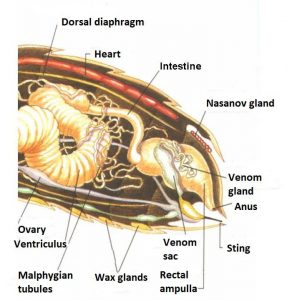 In the anterior part of the sternites of segments four to seven are located the wax glands —four pairs, one for each segment—. In each sternite there are two light-coloured areas called «wax mirrors» that carry pores where the greasy secretion of the wax glands, located in the inner part of each sternite, comes out.
In the anterior part of the sternites of segments four to seven are located the wax glands —four pairs, one for each segment—. In each sternite there are two light-coloured areas called «wax mirrors» that carry pores where the greasy secretion of the wax glands, located in the inner part of each sternite, comes out.
The scales or plates of wax are carried by bees to their mouth with the second pair of legs. Then they use their jaws to knead and shape them to later build the combs. The scales have an irregular pentagon shape and are very small, each weighing 0.0008 g (approx 0.00003 oz). An amount of approximately 1,250,000 flakes are required to produce 1 kg of wax.
Only bees have wax glands. They begin to work approximately at the day 12 of the bee’s life and end at the day 20, when bees become foragers.
To make wax bees have to consume a lot of pollen and honey. When hives are loose bees consume about 15 kg of honey and pollen to produce 1 kg of wax. On the contrary, when hives are strong, they consume only about 10 kg of honey and pollen.
Venom gland
The defence apparatus is indispensable for the survival of the species. Without it, the attraction of honey on men and other animals would have disappeared centuries ago. This defence organ is composed mainly of the sting and the poison bag.
The sting has a pair of lancets attached to each other so that they form a channel, through which poison passes. Then, poison comes out by the curved teeth or beards that gird the tip of the lancets. Each lancet has about nine teeth, with their tips turned back like a hook, and when they dig into the wound, they cannot get it out. When bees try to remove the sting, they are unable to do it, and in this struggle lose this organ and part of the intestine, which leads them to die.
Another component is a whitish vesicle called «venom sac». It contains a liquid that is produced by two glands that drop their secretions in this bag, one of which pours an acidic substance and the other an alkaline substance. None of these substances is toxic itself, but when combined produce a strong irritation with subsequent inflammation.
The defence apparatus possess powerful muscles which bees use to nail the lancets into the wound. They also do contractile movements that last a few minutes after being detached from the bee. Due to those movements, poison is still being introduced into the wound.
The sting of the queen is smooth, curved and somewhat longer than that of workers. It is only used when queens fight each other
Wasps also have a smooth sting and they can nail it several times without the risk of losing it. These stings usually cause more irritation than bees’ ones.
Immune system
The basis of good health in both humans and animals is being able to successfully defend against pathogens (bacteria, parasites, viruses, etc.).
The immune system in insects has been little studied. Insects have chitin —main element of the exoskeleton protection of the intestinal wall on the inside— as protection against aggressions that come from the outside. Bees have immune defences in their body. The cells called hemocytes, of which there are different types, protect bees from the invasion of bacteria and parasites by using several mechanisms: phagocytosis, encapsulation and nodule formation.
The phagocytosis process consists of the emission, by the defence cells, of prolongations that include foreign particles. This process ends the digestion of foreign particles by enzymes that come from the lysosomes. When the foreign body is very large it cannot be phagocytosed and instead is encapsulated. To do this, several hemocytes join together and create a kind of capsule that surrounds it. The lack of oxygen or the accumulation of toxic waste causes the death of the foreign body.
When the number of foreign bodies is very high, the mechanism used is the nodule formation. This mechanism is a kind of mixture of phagocytosis and encapsulation.
The formed nodules adhere to the walls of internal organs where foreign bodies will be destroyed. It has also been possible to demonstrate the existence of not cellular immune defences, apidaecins and lysozymes that develop antibacterial action in the hemolymph.
Apidaecins are formed by groups of polypeptides that have a broad bactericidal power. Lysozymes are enzymes present in small quantities in healthy bees and which increase when bees are infected by bacteria. On the other hand bee colonies react to the presence of pathologies with the elimination of the sick bees and the extraction of the affected broods.
